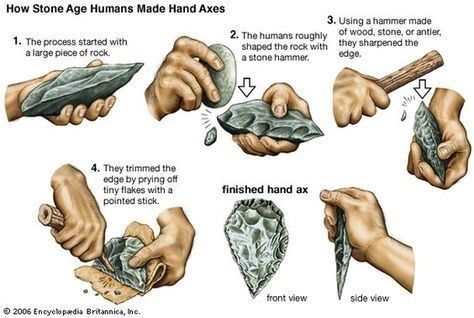Unveiling the Craft: How Stone Age Humans Made Hand Axes
The ingenuity of Stone Age humans shines through in their ability to transform raw materials into essential tools, with the hand axe standing as a pinnacle of early craftsmanship. This detailed guide, inspired by the educational chart titled “How Stone Age Humans Made Hand Axes,” explores the step-by-step process of creating these versatile tools. As of 03:55 PM EDT on Wednesday, July 02, 2025, this post offers a captivating journey into prehistoric technology, providing valuable insights for archaeologists, history buffs, and craft enthusiasts eager to connect with our ancient past.

The Process of Hand Axe Creation
The chart outlines a five-step process, illustrated with detailed hand-drawn sketches, tracing the evolution of a rough stone into a finished hand axe. This methodical approach reflects the practical skills and patience of Stone Age humans, who relied on these tools for survival tasks like hunting, cutting, and processing materials.
- Starting with a Large Piece of Rock: The process begins with selecting a large, suitable piece of rock, typically flint or another hard stone. The chart’s first image shows a hand holding an irregular, unshaped stone, emphasizing the raw material’s natural form. This initial choice was critical, as the stone’s quality determined the tool’s durability and effectiveness.
- Roughly Shaping the Rock with a Stone Hammer: In the second step, humans used another stone as a hammer to roughly shape the rock. The sketch depicts hands striking the stone, with flakes being removed to create a basic outline. This percussion technique, shown with downward arrows, required strength and precision to chip away excess material without fracturing the core.
- Using a Hammer Made of Wood, Stone, or Antler to Shape: The third stage involves refining the shape with a more controlled tool, such as a wooden club, stone hammer, or antler. The chart illustrates a hand wielding a stick-like hammer, striking the stone to further define its form. This step allowed for finer adjustments, removing smaller flakes to approximate the axe’s final silhouette.
- Trimming the Edge by Prying off Thin Flakes with a Pointed Stick: The fourth step focuses on sharpening the edge. The sketch shows a hand using a pointed stick to pry off thin flakes, creating a cutting edge. This delicate process, depicted with a finished hand axe emerging, highlights the skill needed to achieve a functional blade, with the tool’s front and side views showcasing its symmetrical, pointed design.
- Finished Hand Axe: The final product, a polished hand axe, is presented in both front and side views. The chart’s last image shows a hand holding the completed tool, with a sleek, teardrop shape and a sharpened edge. This versatile implement, often hafted to a handle, was ready for use in a variety of tasks, reflecting the culmination of the crafting process.
Techniques and Materials
The process relied on simple yet effective techniques, primarily percussion and pressure flaking. The initial rough shaping used direct percussion with a hammerstone, while the finer trimming employed pressure flaking with a pointed tool, likely made from antler or bone. Materials included flint for its flaking properties, though other hard stones like chert or basalt were also used. The absence of metal tools underscores the reliance on natural resources and manual dexterity.
Historical and Cultural Significance
Hand axes, dating back to the Lower Paleolithic period (approximately 1.7 million to 200,000 years ago), are among the oldest known tools, associated with early hominins like Homo habilis and Homo erectus. Their widespread use across Europe, Africa, and Asia indicates a shared technological knowledge, adapted to local environments. Beyond practicality, these tools may have held cultural value, serving as symbols of skill or status within communities.
Practical Applications
These hand axes were multi-purpose, used for cutting meat, chopping wood, digging, and even as weapons. The teardrop shape, with a broad base for gripping or hafting and a pointed tip, optimized them for diverse tasks. The process’s simplicity allowed for widespread production, making hand axes a staple of Stone Age life.
Exploring Stone Age Craftsmanship
This guide into how Stone Age humans made hand axes, as observed on July 02, 2025, offers a window into our ancestral ingenuity. For enthusiasts, experimenting with flint knapping using modern safety gear and local stones can replicate this process, providing hands-on learning. Visit archaeological museums, study fossil records, or participate in experimental archaeology workshops to deepen your understanding. Whether for historical insight or creative exploration, crafting a hand axe connects us to the roots of human innovation—pick up a stone and begin your own prehistoric journey!



